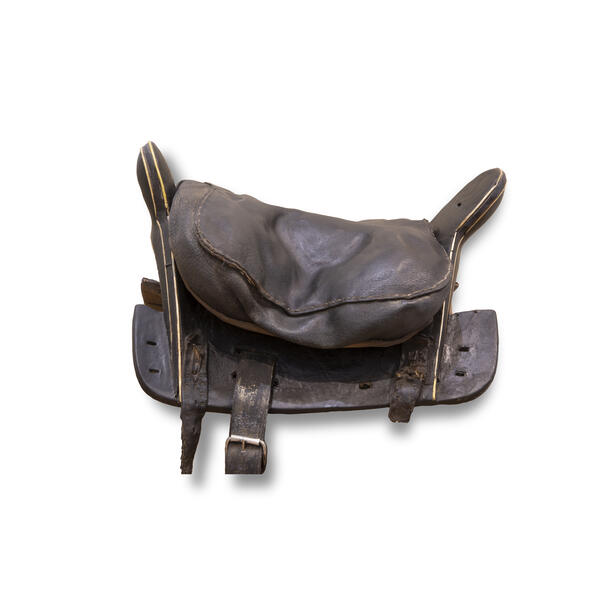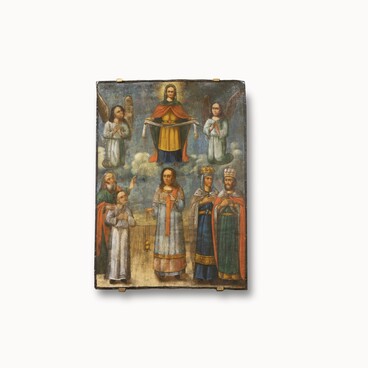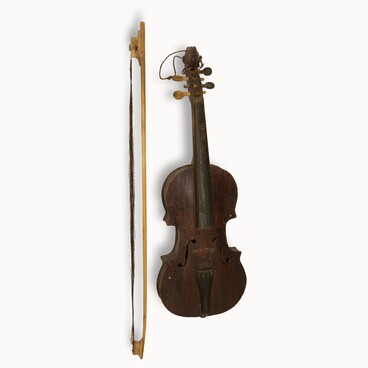A Cossack hacking saddle is a structure for horseback riding that was used in the Don Host Oblast. It had a modular construction and consisted of a rawhide arch, leather straps, metal stirrups, and a panel made of Russian leather, a particular form of cow leather painted black and filled with horsehair. This particular saddle was produced in 1900.
There are hacking and pack saddles. Hacking saddles can be classified into cavalry and Cossack saddles. The latter are lighter, smaller, have an “archak”, which is a modified tree — the solid base made of wood or metal with a cantle and a pommel.
Also, instead of a hard seat, the Cossacks used a soft cushion. It was made of high-quality saddle or chrome-tanned leather, and filled with down feather, wool, hair, feather, or other materials. To the side of the saddle was a skirt, or wings, made of the same material as the cushion. It was black and had an almost square shape without a roller in front. The crupper, or pakhva, made of rawhide served to keep the saddle from sliding forward when riding down a mountain or fancy riding.
In the middle, the cushion was bound to the arch with a saddle girth strap, which is why for the Cossacks (unlike cavalrymen, or modern tourists and athletes) the center of the saddle was its lowest part. Therefore, sitting in a Cossack saddle also felt slightly different.
For example, when using a military saddle, an officer’s saddle, or a racing saddle, a cavalryman sits “as if on a chair”. In a Cossack’s saddle, the legs are almost straight, and the person seems to sit in a cut. When riding at a trot or gallop, Cossacks usually stood on the lowered stirrups, resting against a soft cushion which dampened vertical movement.
Due to the saddle structure, the Cossacks did not wear spurs, using a nagaika to urge a horse instead. Exceptions are the Svodny and Atamansky Life-Guards Cossack Regiments: their uniform featured spurs, but they were mostly decorative.
There are hacking and pack saddles. Hacking saddles can be classified into cavalry and Cossack saddles. The latter are lighter, smaller, have an “archak”, which is a modified tree — the solid base made of wood or metal with a cantle and a pommel.
Also, instead of a hard seat, the Cossacks used a soft cushion. It was made of high-quality saddle or chrome-tanned leather, and filled with down feather, wool, hair, feather, or other materials. To the side of the saddle was a skirt, or wings, made of the same material as the cushion. It was black and had an almost square shape without a roller in front. The crupper, or pakhva, made of rawhide served to keep the saddle from sliding forward when riding down a mountain or fancy riding.
In the middle, the cushion was bound to the arch with a saddle girth strap, which is why for the Cossacks (unlike cavalrymen, or modern tourists and athletes) the center of the saddle was its lowest part. Therefore, sitting in a Cossack saddle also felt slightly different.
For example, when using a military saddle, an officer’s saddle, or a racing saddle, a cavalryman sits “as if on a chair”. In a Cossack’s saddle, the legs are almost straight, and the person seems to sit in a cut. When riding at a trot or gallop, Cossacks usually stood on the lowered stirrups, resting against a soft cushion which dampened vertical movement.
Due to the saddle structure, the Cossacks did not wear spurs, using a nagaika to urge a horse instead. Exceptions are the Svodny and Atamansky Life-Guards Cossack Regiments: their uniform featured spurs, but they were mostly decorative.




